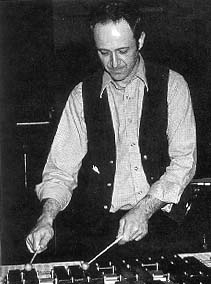OHM- THE EARLY GURUS OF ELECTRONIC MUSIC

photo by Betty Freeman
STEVE REICH on "Pendulum Music"
(April 2000)
I was spending the summer in New Mexico, living and working out there in '68. I went up to Boulder to collaborate with a friend of mine, William Wylie, who's a painter. We were trying to put together a 'happening' with sculpture, black light. While we were working on that, Bruce Nauman, who was a student of Wylie, stopped by. The three of us were in this room and I had one of these Wollensack tape recorders- they're these funky 1950's models with a cheap electric microphone. It was an old machine by then. I had holding the microphone, which was plugged into the back of the machine so it could record. The speaker was turned up. Being out West, I let it swing back and forth like a lasso. As it passed by the speaker of the machine, it went 'whoop!' and then it went away.
We were all laughing at this and the idea popped into my mind that if you had two or three of these machines, you would have this audible sculpture phase piece.
The event that Wylie and I did was the first use of this piece, done with two machines. When it was done as a concert piece at the Whitney Museum in 1969, during an event of my music, it was 'performed' by Bruce Neuman, Michael Snow, Richard Sierra, James Tenney and myself. They pulled back their measured microphones and I counted off 4-4 and on the downbeat, they all let it go and sat down, including me. Then the microphones begin to 'whoop!' as they pass in front of the speaker because the microphones had been preset to be loud enough to give feedback when it's in front of the speaker but not when it swings to the left and the right. Over a period of ten minutes, which was a little too long for my taste, and as the pendulums come to rest, you entered a pulsing drone. Once it hit the drone, I would pull the plug on the machine and the whole thing ended.
It's the ultimate process piece. It's me making my peace with Cage. It's audible sculpture. If it's done right, it's kind of funny.
In my earlier days, I was involved with a lot of visual artists and the context for my work was art galleries and museums. This was definitely such a piece. The work of Richard Sierra was like that where he would have sheets of lead propped up against the wall by other sheets of lead. What you see is what you get. This piece does that and hopefully, it's effect is kind of funny at the same time.
Conceptually, it fits hand-in-glove with my other work. It's a phase piece, a process piece. It's the idea of a piece that runs on its own once you set it up and load it and you can walk away. In terms of what I've done from '65 to the present, it's a totally oddball piece. Bang On A Can did a 60th birthday for me at Lincoln Center (1996) where they performed "Pendulum Music." It's a very provacative piece because it's not something you usually hear at concerts. So, it sits there as kind of a loner.
It's not a piece that needs to be done very often. I was not interested in recording (it). The Avant Garde Ensemble recording is very good- the pitch content becomes kind of a phase piece. They wisely did several versions and presented them all- it's the only piece of mine that doesn't have a sonic outcome. I never have been close to John Cage but this piece was a way of saying "OK, here it is but it isn't!"
I just heard about the Sonic Youth version and now
I have to hear it! Here's a piece that's been unrecorded for
30 years and now I've got two recordings of it!
Also see Reich's comments on his early tape pieces